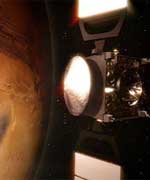
Image credit: ESA
The SPICAM instrument on board ESA?s Mars Express has detected light emissions over the nightside of Mars caused by the production of nitrogen oxide in the atmosphere.
SPICAM is a dual ultraviolet/infrared spectrometer dedicated primarily to the study of the atmosphere and ionosphere of Mars. Spectroscopy of ?airglow? and radiometry are powerful methods for remote sensing investigations of the physics of upper atmospheres of the terrestrial planets.
For instance, Martian ?dayglow? spectra reveal the effect of extreme ultraviolet radiation from the Sun on carbon dioxide in Mars?s upper atmosphere, and show it to be a major heating mechanism and involved in the production of an ionosphere.
?Dayglow? and ?nightglow? effects are emissions of light in the upper atmosphere which are produced when atoms combine to form molecules, releasing energy in the form of photons. Dayglow is visible in the dayside upper atmosphere, and nightglow over the nightside.
The ultraviolet spectrum of the nightglow seen by SPICAM is produced when nitrogen and oxygen atoms combine to produce nitrogen oxide molecules (?recombination?) and release energy.
A similar ultraviolet nightglow on Venus had been detected with Mariner 5 and Pioneer Venus, but the first real evidence for this process was a spectrum acquired with the ESA/NASA International Ultraviolet Explorer satellite which identified the nightglow emissions as coming from nitrogen oxide recombination.
Scientists proposed that nitrogen and oxygen atoms are produced on the Venus day side by a process called ?electron ultraviolet photodissociation?. This is the break-up of oxygen, nitrogen and carbon dioxide molecules by ultraviolet light. The separate atoms were then transported to the nightside where recombination occurs.
These findings were later supported by detailed Pioneer Venus spectra and computer modelling of Venusian atmospheric circulation. Until now, however, this kind of nightglow had never been seen on Mars. It is thought that the mechanism responsible for the nightglow emissions on Mars is the same as that causing the nightglow on Venus.
These nightglow emissions are important tracers of atmospheric transport at high altitudes, which could be used in refining circulation models of the Martian atmosphere.
Original Source: ESA News Release
